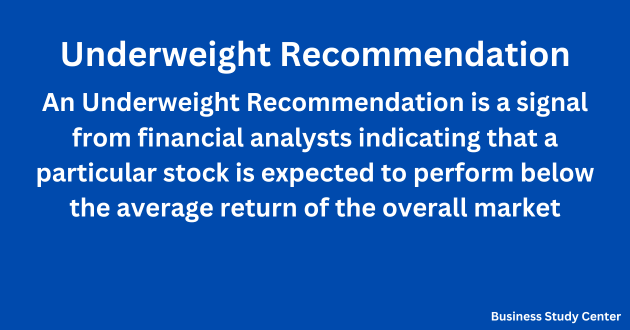
In the world of finance, underweight recommendations play a crucial role in guiding investors’ decisions. When a market analyst designates a stock or security as underweight, they express their belief that the stock will likely underperform compared to a benchmark stock, security, or index. This article delves into the concept of underweight recommendations, shedding light on how they are determined, their implications for portfolios, and the factors investors should consider when interpreting such recommendations.
Understanding Underweight Recommendations
Defining Underweight Recommendations
An underweight recommendation signifies that investors should allocate a smaller percentage of their investment portfolio to holdings in a particular stock or security. It does not necessarily mean that the stock or security is inherently bad. Different analysts may label the same stock as underweight, equal weight, or overweight based on their analysis and perspective. Similarly, underweight can also refer to a portfolio that does not hold sufficient amounts of a specific stock or security in relation to a benchmark portfolio or index.
The Weighting Systems of Market Indices
Market indices, such as the Dow Jones Industrial Average (DJIA), NASDAQ Composite, and the S&P 500, employ various weighting systems to construct an index that accurately reflects overall market performance. For instance, the DJIA uses a price-weighted index methodology and comprises only 30 stocks. Conversely, the S&P 500, with its 500-stock composition, weights stocks by market capitalization. These differing methodologies demonstrate that a stock or security can be considered underweight when compared to one benchmark but may be deemed equal weight or overweight when compared to another.
Factors Influencing Underweight Recommendations
Underweight recommendations are influenced by a multitude of factors, including market conditions, industry trends, and individual stock analysis. Analysts may determine that a stock is underweight based on an expected below-average return compared to the industry, sector, or market chosen as a point of comparison. These determinations are made based on various metrics, such as earnings outlook, price-to-earnings ratio (P/E), and other fundamental and technical indicators.
Implications of Underweight Recommendations
Portfolio Allocation and Diversification
Underweight recommendations have significant implications for portfolio allocation and diversification. When a stock or security is designated as underweight, it implies that its future performance is expected to be below average. Consequently, investors should allocate a smaller portion of their portfolio to such holdings. This approach aims to mitigate potential losses and reduce exposure to underperforming assets.
Portfolio Managers and Underweight Decisions
Portfolio managers play a crucial role in determining the weights of various securities within a portfolio. They may choose to make certain securities underweight based on their analysis and market outlook. By allocating a smaller weight to underperforming securities, portfolio managers aim to enhance overall portfolio performance by redirecting capital towards more promising investments.
Varying Time Horizons and Investment Strategies
It is essential to consider the time horizon and investment strategy when interpreting underweight recommendations. Investors with long-term goals may be willing to hold underperforming stocks in the short term, anticipating that their performance will improve over time. This approach allows them to avoid potential tax implications and transaction fees associated with frequent buying and selling. Understanding one’s investment goals and the time frame for achieving them is crucial when evaluating underweight recommendations.
Evaluating Underweight Recommendations
Alignment of Investment Ideologies and Goals
Investors should consider whether their investment ideologies and goals align with the market analyst issuing the underweight recommendation. Different analysts may have distinct perspectives and approaches to evaluating stocks, which can influence their recommendations. Therefore, it is crucial for investors to assess whether they share a similar outlook and investment philosophy with the analyst in question.
Consistency in Time Horizons
Analysts and investors may differ in their time horizons when issuing or considering underweight recommendations. Some investors prioritize long-term growth and are willing to withstand short-term fluctuations, while others focus on short-term gains. It is important to ensure that the analyst’s time horizon aligns with the investor’s goals to make informed investment decisions.
Evaluating the Analyst’s Credibility
Investors should assess the credibility and track record of the analyst issuing the underweight recommendation. A reputable and experienced analyst with a history of accurate predictions may carry more weight in their recommendations. However, it is essential to recognize that even the most reputable analysts can be incorrect in their assessments, and past performance is not always indicative of future accuracy.
Conclusion
Underweight recommendations hold significant implications for investors, providing guidance on portfolio allocation and diversification. Investors should interpret such recommendations with caution, considering factors such as their investment goals, alignment with the analyst’s perspective, and the time horizon of their investments. Understanding underweight recommendations and their underlying analysis can help investors make informed decisions and navigate the complex world of financial markets.
Note: The information provided in this article is for educational purposes only and should not be considered as financial advice. It is always recommended to consult with a qualified financial advisor before making any investment decisions.


